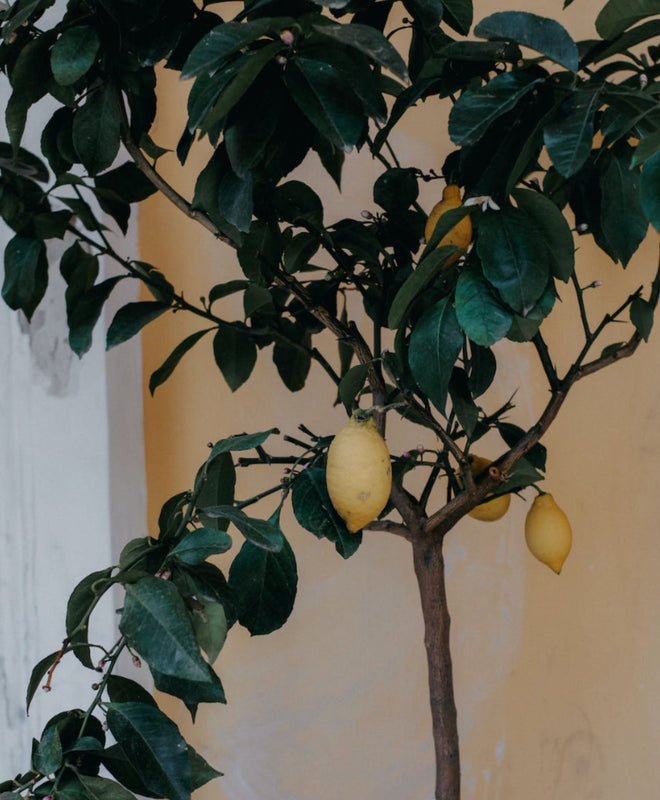
Care sheet: Lemon tree
Pas le temps de tout lire ? 👇Cliquez ici pour un résumé👇
Sommaire

Whatever the season, and wherever its habitat is, a lemon tree floods you with its benefits every day. Tasty plant par excellence, its virtues are as much medicinal as adorned with a thousand and one ancestral predictions.
Its oriental origins make it an exotic companion, which likes to deploy in a temperate climate. It is particularly easy to grow in Mediterranean and southern regions.

- Maintenance sheet -
☀️ Exposure: Good light is necessary for it, avoid sudden temperature variations.
💧 Watering: As soon as the motte seems dry to you, you have to water it. However, if your lemon tree is potted, once a week is enough. In fall and winter opt for misting the foliage. Do not hesitate to provide it with a special fertilizer from March to September, so every 15 days is enough for one out of two operations.
❌ Cultivation errors: Its first watering must be copious, but do not let water stagnate in the saucer of the pot, a well-drained lemon tree will do better. If its leaves turn yellow, it is a sign of iron deficiency. Replace part of the soil with a mixture of compost, potting soil and special citrus fertilizer. It could also be due to excess heat, so place it in an unheated room.
🌿 Maintenance: The size of the lemon tree is essential for better fruiting. Prune your lemon tree about 20 cm a month after the appearance of new shoots.
🤢 Diseases and pests :
A disease called gummosis can seriously affect it, as for pests fear aphids and scale insects .
Cultivation errors are often the cause of the appearance of gummosis ! The best remedy is to disinfect your tools with rubbing alcohol to prevent the spread. Regarding the intrepid pests, some clues to follow:
Consequences: The insects will deposit honeydew on its leaves, thus attracting and spreading the sooty mold which will blacken them.
Solution: These attacks are simple to avoid and easy to deal with. Early on, just spray a mixture of water and black soap on the leaves. In the event of a more extensive infestation, pass a sponge soaked in the mixture over and under the foliage.
🌱 How to repot a lemon tree :
Planting for pot culture: The priority is to choose a variety adapted to your climate, in the capital favor pot planting. You can thus leave your lemon tree in the open air in the summer, and place it under a veranda during the winter.
- Opt for a species with a small development, with a container to suit it, and prune it accordingly. Lemon cultivation requires as much sun as moisture and heat during the winter. To avoid drying out, it is imperative to protect it from wind and frost. For example, you can let it run on the wall of a south-facing veranda.
- During its installation, prepare its roots well at the ends, which are to be cut cleanly. Bathe them in praline, this clayey mud will protect them and stimulate their recovery. In particular, you can put clay balls in it. To improve drainage, do not hesitate to place them on a bed of gravel. Offer a mixture of sand and compost to the earth, the lemon tree will give it back to you.
- During maintenance pruning, intended to remove old branches, protect the wounds with a suitable mastic. This is because the lemon tree does not heal well, so a light pruning every other year is sufficient after fruiting. On the other hand, it is necessary to renew its stems, as well as to limit your tree to more reasonable proportions.
👍🏼 Good to know:
The level of maturity is quite difficult to estimate because for the lemon it is spread over the whole year. You do not make a mistake by harvesting as soon as the color of the bark turns bright yellow. Well wrapped, you can keep it in the refrigerator for two months, or two weeks at room temperature.
Note: If you have displayed your lemon tree in a friendly place, your balcony for example, it is possible to collect its fruits for any occasion. Its juice, once pressed and frozen, can very well turn into ice cubes... not practical!
Written by Arthur Delrieu